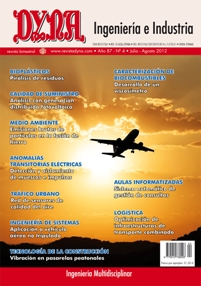QUANTIFYING FOOTBRIDGES SERVICEABILITY
Keywords:
pasarelas peatonales, vibración, percepción, disconfort, serviciabilidadAbstract
Modern pedestrian bridges are very often slender and very flexible structures, where the first natural frequencies of vibration may fall close to dominant frequencies of the dynamic excitation due to walking or running. Pedestrian loads are low intensity quasi-periodic loads. Applied to very stiff and massive structures this loads could hardly make them vibrate significantly. Aesthetic, technical and technological developments lead to ever more slender, flexible and low damped footbridges and, as a consequence, they can vibrate significantly even under a single person and frequently require a thorough dynamic analysis. Some codes, standards or guidelines establish acceptable values in terms of acceleration functions. In many of these codes, dynamic problems are addressed by defining limits for the natural frequencies of the structures or for the accelerations associated with pedestrian-induced vibrations. Such approaches are usually conservative and fail to deal with all the parameters relevant to human sensitivity to vibrations, which is highly subjective. This, together with the fact that the natural frequencies and accelerations calculated by analytical or numerical methods are subject to uncertainties, may hinder pedestrian bridge design. In general, the perception and the individual judgement, whether vibrations are disturbing or not, are based on psychological parameters and can lead to different limits, as certain persons can detect vibrations without being discomforted by them. Some of these parameters are difficult to quantify or are highly subjective. They include the number of simultaneous users, frequency of use, pedestrians’ activity (walking, jogging, standing or sitting on the bridge), flexibility of the pavement, time of exposure, deck and guard rail transparency, height over ground level, footbridge appearance, if vibration is expected or not, etc. In this work the vibration perception is addressed and certain applied approaches are presented.Downloads
Published
2012-06-28
Issue
Section
ARTICULOS

